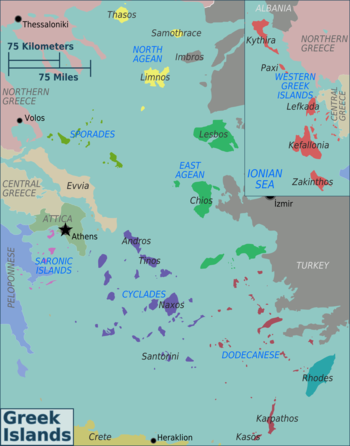
Back Бырзен адгьылбжьахақәа рсиа Abkhazian قائمة جزر اليونان Arabic الجزر اليونانيه ARZ Insln in Griachaland BAR Астравы Грэцыі Byelorussian Острови на Гърция Bulgarian Listenn inizi Gres Breton Spisak ostrva u Grčkoj BS Llista d'illes de Grècia Catalan Seznam ostrovů Řecka Czech

Greece has many islands,[Note 1] with estimates ranging from somewhere around 1,200[1] to 6,000,[2] depending on the minimum size to take into account. The number of inhabited islands is variously cited as between 166[3] and 227.[2]
The largest Greek island by both area and population is Crete, located at the southern edge of the Aegean Sea. The second largest island in area is Euboea or Evvia, which is separated from the mainland by the 60m-wide Euripus Strait, and is administered as part of the Central Greece region. After the third and fourth largest Greek islands, Lesbos and Rhodes, the rest of the islands are two-thirds of the area of Rhodes, or smaller.
The Greek islands are traditionally grouped into the following clusters: the Argo-Saronic Islands in the Saronic Gulf near Athens; the Cyclades, a large but dense collection occupying the central part of the Aegean Sea; the North Aegean islands, a loose grouping off the west coast of Turkey; the Dodecanese, another loose collection in the southeast between Crete and Turkey; the Sporades, a small tight group off the coast of Euboea; and the Ionian Islands, chiefly located to the west of the mainland in the Ionian Sea. Crete with its surrounding islets and Euboea are traditionally excluded from this grouping.
This article excludes the Peloponnese, which has technically been an island since the construction of the Corinth Canal in 1893, but is rarely considered to be an island due to its artificial origins.
Cite error: There are <ref group=Note> tags on this page, but the references will not show without a {{reflist|group=Note}} template (see the help page).
- ^ John S. Bowman; Sherry Marker; Peter Keraislands siotis; Heidi Sarna (2010). "Greece in depth". Frommer's Greece (7th ed.). Hoboken, NJ: Wiley Publishing. p. 12. ISBN 978-0-470-52663-7.
- ^ a b "Islands". Visit Greece - Official website of the Greek National Tourism Organisation. Hellenic Organization of Tourism (EOT; Ελληνικός Οργανισμός Τουρισμού). Retrieved 7 February 2022.
- ^ Poffley, Frewin (20 December 2012). Greek island hopping, 23rd ed. 2013. Thomas Cook Publishing. p. 15. ISBN 978-1-84848-569-3. OCLC 827800689.